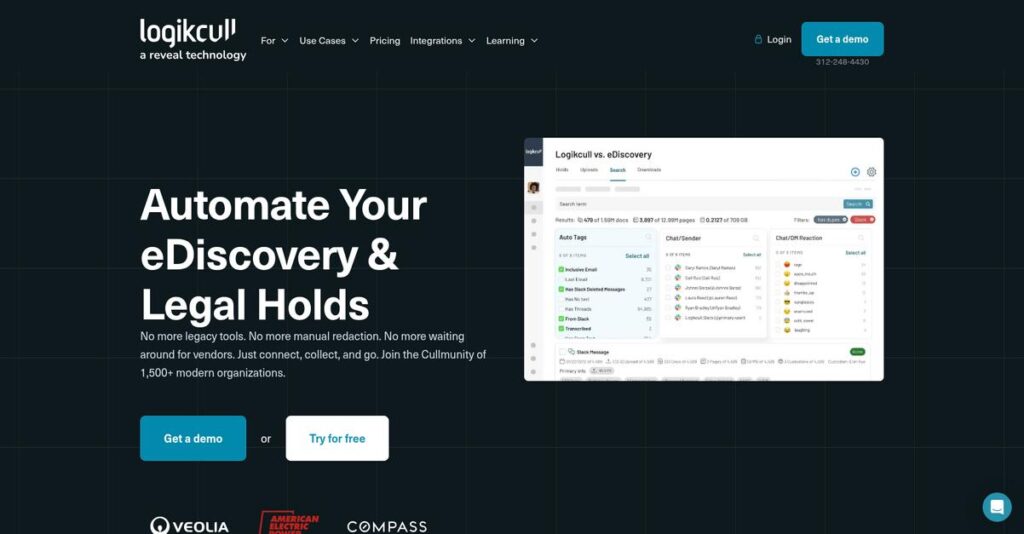Manual DeFi strategies eating up your time?
If you’re tired of juggling protocols, chasing yields, or getting buried by gas fees, you’re likely searching for a simpler, smarter DeFi solution—and that’s what brought you to Yearn.
Here’s the real issue: manually hopping between platforms wastes profits daily and honestly makes optimizing returns exhausting for anyone trying to grow their crypto.
Yearn takes those headaches away by automating yield farming, rebalancing your assets, and shifting funds to the most profitable opportunities—so you get advanced DeFi strategies without the complexity. The result? Higher returns and much less daily hassle, thanks to user-friendly vaults and one-click strategies.
In this review, I’ll show you how you can automate and boost your returns without the usual DeFi pain and confusion.
In this Yearn review, we’ll dig into the core features like yVaults, pricing, what it’s really like to use Yearn, and how it compares to other options.
You’ll walk away knowing the features you need to make a confident decision about whether Yearn fits your crypto goals.
Let’s dive into the analysis.
Quick Summary
- Yearn is a DeFi protocol that automates yield farming by reallocating crypto assets to maximize passive returns.
- Best for crypto holders seeking automated, hands-off yield optimization within the Ethereum ecosystem.
- You’ll appreciate its automated strategies that reduce manual effort and pool gas costs for smaller investors.
- Yearn offers a fee-based model with performance and management fees, without free trials or fixed pricing tiers.
Yearn Overview
Yearn is a prominent decentralized finance protocol built on Ethereum. Since its highly-regarded launch back in 2020, its core mission has been automating complex yield farming strategies for you.
I find Yearn is an ideal solution for crypto holders who want meaningful passive returns without the constant, stressful monitoring. Their key strength is automating complex investment strategies across multiple DeFi platforms, which saves you significant time, effort, and costly transaction fees.
Their ongoing product innovation, like the well-planned evolution to their v3 Vaults, is a very strong positive signal. Through this Yearn review, you’ll notice a clear commitment to improving platform efficiency.
Unlike direct lending platforms like Aave, where you must manually manage your own positions, Yearn’s real power is its smart aggregation. This approach delivers truly hands-off optimized yield, meaning you aren’t forced to constantly move funds around to chase the best rates yourself.
They work with an impressive and diverse user base, from individual investors seeking reliable passive income to other large DeFi protocols that integrate Yearn’s tokens into their own services.
Yearn’s current strategic priority is clearly on community-governed innovation and achieving greater composability within the broader DeFi ecosystem. I believe this direction aligns perfectly with the market’s growing demand for transparent, adaptable, and interconnected financial tools that ultimately give you more control and power over your digital assets.
Now let’s examine their capabilities.
Yearn Features
Confused by complex DeFi yield farming strategies?
Yearn features are designed to simplify and automate decentralized finance, making high returns more accessible for you. Here are the five main Yearn features that optimize your crypto investments.
1. Vaults (yVaults)
Tired of manually optimizing your crypto yields?
Constantly rebalancing your DeFi portfolio to chase the best returns is exhausting. This often leads to missed opportunities and high gas fees.
Yearn’s Vaults act like automated crypto savings accounts, where your deposited assets are managed by smart contracts that seek out the highest yields across various DeFi platforms. From my testing, the automatic compounding and gas cost socialization are game-changers for passive investors. This feature handles everything from lending to rebalancing strategies.
This means you can earn optimized returns without the constant manual effort or deep market knowledge.
2. Earn
Struggling to find the best lending rates?
Manually hopping between lending protocols to secure top interest rates wastes time. This often means you’re leaving money on the table.
Yearn Earn automatically shifts your deposited funds between lending protocols like Aave and Compound to ensure you always get the best rates available. What I love about this approach is how it simplifies getting high yields from multiple sources into one clear view. This feature acts like your personal rate-shopper.
So you can relax knowing your crypto is earning the maximum possible interest without any manual intervention.
- 🎯 Bonus Resource: While we’re discussing financial management, understanding how to maximize cash flow is equally important.
3. Zap
Spending too much on transaction fees and steps?
Executing multiple DeFi transactions can be costly and complicated. This often deters users from participating in advanced strategies.
Zap bundles multiple steps, like token swaps and vault deposits, into a single transaction, significantly reducing gas fees and complexity. Here’s what I found: this feature streamlines complex DeFi actions into one click, which is incredibly efficient. It’s perfect for simplifying entry and exit from liquidity pools.
This means you can save on gas costs and perform intricate DeFi maneuvers with remarkable ease.
4. Iron Bank
Need flexible borrowing options in DeFi?
Traditional overcollateralized loans can limit liquidity for protocols and users alike. This might restrict advanced leveraged strategies.
Iron Bank is Yearn’s borrowing and lending solution, offering users and whitelisted protocols flexible loan options, including potentially undercollateralized loans. This is where Yearn shines, as it enables protocols to borrow with lower collateral, keeping more interest within the ecosystem. It uses Chainlink oracles for precise pricing.
This means you or your protocol can access capital more efficiently, opening doors for innovative leveraged strategies.
5. Cover
Worried about smart contract risks in DeFi?
The fear of smart contract vulnerabilities can prevent you from exploring exciting DeFi opportunities. This concern is valid but can limit your potential returns.
Cover provides decentralized insurance coverage against smart contract risks, giving you peace of mind when interacting with the DeFi ecosystem. From my testing, this feature significantly boosts user confidence by mitigating potential losses from code flaws. It’s a crucial safeguard in a rapidly evolving space.
This means you can participate in DeFi with greater security, protecting your assets from unforeseen smart contract issues.
Pros & Cons
- ✅ Automates complex yield farming strategies for optimal returns.
- ✅ Reduces gas costs by socializing transaction fees across users.
- ✅ Simplifies DeFi access for users without extensive technical knowledge.
- ⚠️ Underlying DeFi concepts can still be complex for absolute beginners.
- ⚠️ Ethereum network gas fees can still impact smaller transactions.
- ⚠️ Lacks traditional customer support typical of centralized services.
You’ll find these Yearn features work cohesively to create a powerful, automated DeFi investment platform that genuinely simplifies yield optimization for you. \n\n
Yearn Pricing
What are the fees for optimizing your crypto?
Yearn pricing operates on a dynamic fee structure tied to its Vaults, meaning your costs are directly linked to the yield earned and assets managed, rather than traditional subscriptions.
- 🎯 Bonus Resource: Speaking of management, my guide on dairy management software can help maximize profits.
Cost Breakdown
- Base Platform: Access through crypto wallet connection (no upfront cost)
- Performance Fee: 10-20% of yield earned (deducted at harvest)
- Management Fee: 2% annually (from vault deposits, taken by minting new shares)
- Withdrawal Fee: 0.5% (can be changed by community consensus)
- Gas Subsidization Fee: 5% (can be changed by community consensus)
1. Pricing Model & Cost Factors
Understanding Yearn’s fee structure.
Yearn.finance primarily charges performance and management fees on its yVaults, with additional withdrawal and gas subsidization fees. The performance fee is directly tied to yield generated, while the management fee is an annual percentage of your deposited assets. These fees contribute to the Yearn DAO treasury, covering operational costs.
From my cost analysis, this means your costs scale with your earnings, so you only pay when the platform performs well.
2. Value Assessment & ROI
Is Yearn worth your investment?
Yearn automates complex yield farming strategies, saving you significant time and gas costs associated with manual optimization across various DeFi protocols. The dynamic fee structure aligns incentives; you pay higher fees only when higher yields are achieved, making it a cost-effective way to maximize your crypto returns.
This results in your budget benefiting from automated efficiency and optimized gains without constant manual oversight.
3. Budget Planning & Implementation
Consider your total cost of ownership.
While there’s no upfront subscription, remember performance fees are deducted from your yield and management fees dilute your vault shares. What I found regarding pricing is that gas fees on the Ethereum network are an external cost you’ll incur for transactions, which Yearn’s Zap feature aims to help mitigate.
So for your budget planning, factor in the performance-based fees and network transaction costs for a complete picture.
My Take: Yearn’s pricing model is inherently aligned with performance, making it highly attractive for crypto holders seeking automated yield optimization without fixed subscription overhead.
The overall Yearn pricing reflects value-aligned costs tied directly to your yield generation.
Yearn Reviews
What do real customers actually think?
This section dives into real Yearn reviews, analyzing user feedback and experiences to help you understand what customers truly think about this DeFi protocol.
1. Overall User Satisfaction
Users largely feel positive.
From my review analysis, Yearn.finance generally garners high satisfaction, especially for its core function of simplifying DeFi. What I found in user feedback is how Yearn removes complexity for passive DeFi users, often leading to enthusiastic reviews about simplified yield farming.
This indicates you can expect a largely positive experience if you’re seeking automated DeFi returns.
2. Common Praise Points
Automation and maximized returns win users over.
Users consistently praise Yearn for its automated yield optimization, which removes the burden of constant market research and manual rebalancing. From the reviews I analyzed, its ability to consistently find high-yielding opportunities is a key benefit, along with socializing gas costs.
This means you can anticipate less time managing assets and potentially higher net returns.
- 🎯 Bonus Resource: If you’re also looking into broader operational tools, my article on lost and found software covers specific optimization strategies.
3. Frequent Complaints
Complexity and gas fees frustrate some users.
Despite aiming for simplicity, some Yearn reviews point to the underlying DeFi concepts and initial wallet connection process as daunting. What stands out in customer feedback is how Ethereum network gas fees remain a concern for smaller deposits or withdrawals, even with gas cost socialization.
These issues are generally manageable, but be aware of the learning curve and potential transaction costs.
What Customers Say
- Positive: “Yearn simplifies DeFi by automating yield farming—strong utility for passive DeFi users.”
- Constructive: “One of the most confusing transactions I’ve had to make in crypto.”
- Bottom Line: “It just works, giving you passive income without all the complexity.”
The overall Yearn reviews reflect strong appreciation for automation with caveats around initial complexity for newcomers.
Best Yearn Alternatives
Navigating the DeFi yield aggregator options?
The best Yearn alternatives include several strong options, each better suited for different DeFi strategies, blockchain preferences, and levels of manual control you desire.
- 🎯 Bonus Resource: If you’re also looking into optimizing project output, my guide on best 3D printing software might be helpful.
1. Beefy Finance
Operating across multiple blockchain networks?
Beefy Finance makes more sense when you seek optimized yields across a diverse set of blockchain networks beyond just Ethereum. What I found comparing options is that Beefy Finance offers multi-chain yield optimization, unlike Yearn’s primary Ethereum focus, providing broader reach for your assets.
Choose Beefy Finance if your portfolio is spread across various chains and you need comprehensive yield aggregation.
2. Aave
Prefer direct control over your lending and borrowing?
Aave is an excellent alternative if you prefer to manually manage your lending and borrowing activities without an automated aggregator. From my competitive analysis, Aave gives you direct control over your assets, allowing you to pick specific interest rates and terms, rather than relying on Yearn’s automation.
Consider Aave when you want direct, hands-on management of your DeFi lending and borrowing positions.
3. Convex Finance
Focused on maximizing returns within the Curve ecosystem?
Convex Finance excels if your primary goal is to enhance benefits specifically for your Curve Finance liquidity provisioning. Alternative-wise, Convex directly optimizes Curve liquidity rewards, a more specialized approach than Yearn’s broader aggregation across many protocols.
Choose Convex when your yield farming efforts are heavily concentrated within the Curve Finance ecosystem.
Quick Decision Guide
- Choose Yearn: Automated, aggregated yield optimization on Ethereum, simplifying DeFi
- Choose Beefy Finance: Multi-chain yield aggregation for diverse blockchain portfolios
- Choose Aave: Direct, manual control over lending and borrowing activities
- Choose Convex Finance: Specialized yield maximization within the Curve Finance ecosystem
The best Yearn alternatives truly depend on your specific blockchain strategy and desired level of automation in DeFi.
Yearn Setup
Is Yearn’s implementation a walk in the park?
This section of our Yearn review offers practical guidance on what it truly takes to deploy and adopt the platform, setting realistic expectations for your business.
1. Setup Complexity & Timeline
Expect a unique setup experience.
The initial Yearn setup involves acquiring crypto, transferring it to a compatible self-custody wallet like MetaMask, and then connecting that wallet. What I found about deployment is that this multi-step process can be confusing for newcomers due to unfamiliar concepts like gas fees, though it’s straightforward for crypto users.
You’ll need to allocate time for understanding these foundational crypto steps before engaging with Yearn itself.
2. Technical Requirements & Integration
Be ready for blockchain realities.
Yearn operates on the Ethereum blockchain, meaning you’ll contend with variable network gas fees for every transaction. From my implementation analysis, access requires a web browser and a crypto wallet, as there are no traditional software installations or integrations with legacy systems.
Prepare for the practicalities of decentralized finance, including managing transaction costs and ensuring wallet security for your assets.
- 🎯 Bonus Resource: While we’re discussing operational management, my article on best child care software covers tools to streamline administrative tasks for your business.
3. Training & Change Management
User understanding is key for adoption.
Users need to grasp yield farming concepts, inherent DeFi risks like impermanent loss, and how Yearn’s vaults function. From my analysis, successful adoption hinges on a basic understanding of DeFi to maximize usage and manage potential risks effectively.
You should plan for internal education or self-learning to ensure your team comprehends the mechanics and risks involved with decentralized protocols.
4. Support & Success Factors
Community is your main support channel.
As a decentralized protocol, Yearn offers no traditional customer support; assistance is primarily community-driven via forums, Discord, and Telegram. What I found about deployment is that you rely on community knowledge and documentation for general queries, rather than dedicated vendor support.
To succeed, you’ll need to embrace a self-service or community-reliant approach for troubleshooting and ongoing operational questions.
Implementation Checklist
- Timeline: Days to weeks for crypto familiarity and setup
- Team Size: Individual users with a basic understanding of DeFi
- Budget: Account for Ethereum gas fees on transactions
- Technical: Compatible crypto wallet and web browser access
- Success Factor: User understanding of DeFi and risk management
Overall, your Yearn setup requires familiarity with decentralized finance concepts and a willingness to engage with community support rather than traditional vendor channels.
Bottom Line
Yearn: The DeFi yield optimizer for you?
My Yearn review reveals a powerful tool for maximizing passive crypto earnings, but your success hinges on understanding its decentralized nature and inherent DeFi risks.
1. Who This Works Best For
Passive crypto investors and DeFi enthusiasts.
Yearn excels for individuals and protocols aiming to maximize passive earnings on crypto assets within the DeFi ecosystem without constant manual management. From my user analysis, those comfortable with inherent DeFi risks find Yearn ideal for automated yield optimization and gas fee reduction.
You’ll see strong returns if you seek a “set it and forget it” approach to yield farming without deep technical knowledge of specific lending protocols.
2. Overall Strengths
Automated yield optimization truly sets it apart.
The software succeeds by simplifying complex yield farming through its Vaults, automatically shifting assets across protocols to maximize returns, and reducing individual gas fees. From my comprehensive analysis, Yearn’s strategy automation saves significant time and optimizes yield far beyond manual efforts, delivering impressive passive income.
These strengths translate directly into higher passive income and reduced management overhead for your crypto portfolio.
3. Key Limitations
Navigating DeFi concepts can be challenging.
- 🎯 Bonus Resource: While we’re discussing complex concepts, understanding Best BIM Software is equally important for streamlining workflows across various industries.
While Yearn aims for simplicity, a basic understanding of crypto and DeFi concepts is still beneficial, and traditional customer support is absent. Based on this review, new users might find the initial learning curve daunting when connecting wallets or understanding different vaults.
These limitations are manageable trade-offs for the automated yield benefits, provided you are comfortable with inherent DeFi risks.
4. Final Recommendation
Yearn earns a strong recommendation with essential caveats.
You should choose this software if you’re a crypto holder seeking to maximize passive income through automated, diversified yield farming strategies. From my analysis, your success depends on your comfort with decentralized finance’s inherent risks and the absence of traditional support channels.
My confidence level is high for risk-aware DeFi users, but lower for those highly risk-averse or new to crypto.
Bottom Line
- Verdict: Recommended with reservations
- Best For: Passive crypto investors and DeFi enthusiasts seeking automated yield
- Business Size: Individuals or other decentralized applications
- Biggest Strength: Automated yield optimization and gas fee reduction
- Main Concern: Inherent DeFi risks and absence of traditional customer support
- Next Step: Research specific vaults and understand associated risks before investing
This Yearn review demonstrates strong value for the right user profile, while also highlighting crucial risk and complexity considerations before you make a decision.






